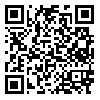Volume 7, Issue 6 (2-2012)
J Health Syst Res 2012, 7(6): 0-0 |
Back to browse issues page
Download citation:
BibTeX | RIS | EndNote | Medlars | ProCite | Reference Manager | RefWorks
Send citation to:



BibTeX | RIS | EndNote | Medlars | ProCite | Reference Manager | RefWorks
Send citation to:
آسيه پيرزاده. بررسی عملکرد دانشجویان دانشگاه علوم پزشکی اصفهان در زمینه مصرف قرصهای اکستازی بر اساس مدل اعتقاد بهداشتی در سال 89. J Health Syst Res 2012; 7 (6)
URL: http://hsr.mui.ac.ir/article-1-305-en.html
URL: http://hsr.mui.ac.ir/article-1-305-en.html
PhD Candidate, Student Research Committee, Department of Health Education and Promotion ,School of Health , Isfahan University of Medical Sciences, Isfahan, Iran.
Abstract: (1749 Views)
Background: Use of ecstasy tablets has increased 70% worldwide and now its consumption is more than heroin and cocaine. Surveys show that students use ecstasy pills more than other groups. During recent years, the use ecstasy has increased in students. Thus, this study aimed to determine the practice of student of Isfahan University of Medical Sciences based on health belief model in 2011. Methods: This descriptive-analytical study was conducted on 267 students of Isfahan University of Medical Sciences. Data were collected by a validated and reliable questionnaire consisting of 3 parts, which were demographic information, H.B.M variables, and practice. Finally, descriptive analysis, chi-square, t-test and Kruskal-Wallis were used to analyze data. Finding: The mean age of the participants was 20.95 ± 1.61, 39.3% of them were men and 90.6% were single. 22.1% of students have seen ecstasy pills and 2.2% of them have used these pills. The mean scores of H.B.M variables were, perceived susceptibility 72.75 ± 19.68, perceived severity 84/58 ± 16/96, perceived benefits 80.43 ± 23.49, and perceived barriers 81.65 ± 18.53. There were no significant differences between the H.B.M variables and sex (p > 0.05). Moreover, television was the most important source of information and most important tool for teaching students about Ecstasy. Conclusions: Considering the mean of H.B.M variables and the amount of use of ecstasy (2.2% of students) in this group, it seems that educational programs based on the Health Belief Model are effective in decreasing the use of ecstasy tablets.
Type of Study: Research |
Subject:
education health and promotion
Received: 2020/07/16 | Accepted: 2023/03/4 | Published: 2023/03/4
Received: 2020/07/16 | Accepted: 2023/03/4 | Published: 2023/03/4
| Rights and permissions | |
 |
This work is licensed under a Creative Commons Attribution-NonCommercial 4.0 International License. |





